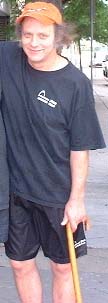|
|
|
| bo home : : bo coach : : bo player : : bo notes : : bo sightings : : bo stories : : bo knows | |

|
VISUALIZATION, IMAGERY, THE POINT OF "AHA!", and the MAGIC WORD "YES" Here are four techniques anyone can use to get better at practically anything. I can guarantee you they all work for racquetball. Most successful athletes use some or all of these techniques in one form or another. VISUALIZATION is the most common of the four; and although most of you have probably used it at some time, its power must not be overlooked. It simply refers to imagining or picturing yourself performing perfectly. You should learn to do this so well that you can close your eyes and see yourself as clearly as if you were watching a movie or video. (Then you should learn to do this with your eyes open as well.) The nice thing about visualization is that in your mind's eye you can always be perfect - there's never any need to make a mistake. Usually the best way to begin to develop this technique is to learn to watch others so clearly that you can see them clearly in your mental movie. It's best to watch people who perform as well as you would like to be able. (That is why so many people make such a big deal over watching the pros.) Then it's simply a matter of substituting yourself in the movie; you may have to watch yourself a bit in a mirror or on video to get a clear picture of what you look like. Okay, you can visualize - now what? Now you use this skill intelligently, visualizing when it does you the most good. Some key times are right before going to sleep, shortly after waking up, and shortly before and after performing for real what you've been working on. If you've made mistakes while actually performing, it's often helpful to cover the memory of the mistakes with mental memories of perfect performance instead, rather than dwell overlong on replaying the mistakes in your mind.
IMAGERY goes one step beyond visualization. Sherman
Greenfield really emphasizes this concept in his
teaching. Sherman is a legendary Canadian racuetball
player with I-don't-know-how-many national and world
titles to his credit. He is also an incredible,
knowledgeable teacher whose enthusiasm can fill a room
of any size. He encourages students to IMAGINE in a
way that involves all the senses. Rather than merely
seeing yourself playing great racquetball, FEEL it --
feel the racquet in hand, the ball meeting the
racquet, hear the sound, smell the new ball, feel your
body performing excellently, hear and sense the
spectators, feel the thrill of scoring the winner, of
winning match point in the finals of the big one...all
of these things in addition to seeing these things in
your mind's eye. This is imagery.
^ back to the top ^ |
Sometimes, when you're trying to learn a new skill, you may make 10, 20, 100 or more attempts without doing it well. Then (often by accident), everything falls into place and you are successful. If you have been patient and stayed alert, then you have just reached THE POINT OF "AHA!", so named because a common reaction is to think: "AHA!", "THAT'S what that feels like!" Once you know what it feels like to do it well, then often you will be able to perform well on most of your successive attempts. When struggling to learn new skills, it's very helpful to know that there is a point of "AHA!" - maybe just around the corner. This knowledge can help you be patient, determined, and alert enough to actually be feeling what your body is doing. So in your attempts at learning, try to keep your sights set on reaching that point of "AHA!", rather than getting too hung up on all your mistakes. So now what do you do when you reach the point of "AHA!"? Now it's time to invoke the MAGIC WORD "YES". When you do something well, giving yourself a positive mental stimulus makes it more likely that you will do it well in the future. Saying "YES" is an effective way to do this. You can say it out loud, you can say it under your breath, you can say it mentally, you can scream it with lots of emotion, you can think it with powerful emotion or quiet, calm, confidence.....just use the word! And use it every time you do something well - make a habit of it. Your body tends to do the things you dwell on the most. So when you make a mistake - especially when trying to learn - it's often best to react with no emotion. Then when you do well - "YES"! So there you have it: four techniques you can use to help yourself improve at most anything. Put them all together and watch your learning curve skyrocket!
Hope this helps anyone who is teaching or learning the game. I'll try to answer any questions readers may have on teaching, learning, coaching, or being coached. Until I can persuade the Webmaster to put a place to >>email<<< here, you can go to the "bo stories" link and send an email from there. Over and out for now...... bo
|
|
Copyright © 2003 bo champagne Web Site designed and maintained by |